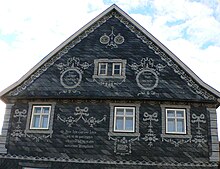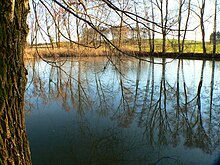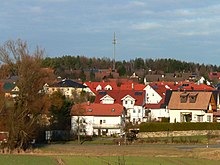Scheuerfeld (Coburg)
|
Scheuerfeld
independent city of Coburg
|
|
|---|---|
| Coordinates: 50 ° 15 ′ 12 ″ N , 10 ° 55 ′ 32 ″ E | |
| Height : | 351 m |
| Area : | 4.83 km² |
| Residents : | 2364 (Apr 12, 2007) |
| Population density : | 489 inhabitants / km² |
| Incorporation : | July 1, 1972 |
| Postal code : | 96450 |
| Area code : | 09561 |

Scheuerfeld is a western part of the Upper Franconian city of Coburg with around 2500 inhabitants and an area of 4.83 square kilometers. This results in a population density of 502 per square kilometer. Scheuerfeld borders the Coburg core city as well as the Coburg district Wüstenahorn and the communities of Weitramsdorf and Ahorn .
Geography and geology
The predominant rock in the Scheuerfeld area is the arkosedolomite, dolomite accompanied by arkose sandstone . This type of rock stretches northwest to Schlettach and Mehrehausen , and in a southeast direction to Stöppach . The soil is stony and not very deep and therefore not very attractive for agricultural use. The highest point in Scheuerfeld is the Kanzelberg at 391.5 meters.
Schematic representation of the adjacent places:
| Weidach | Beiersdorf | Core city Coburg |
| Weitramsdorf |

|
Core city Coburg |
| Hergramsdorf | Schorkendorf |
Desert maple maple |
history
Before 1588
On the almost five square kilometers large area of Scheuerfeld there are hill courtyards and tower hills in several places , which suggest a settlement that goes back at least to the early Middle Ages. There are no reliable finds about a possible settlement at the time of the Celts or even earlier.
The first written mention of Scheuerfeld is dated to the year 1100. In the copy book of the Propstei Coburg of the Benedictine monastery Saalfeld there is a copy of the text of a document from the year 1100. With this a Sibot and his wife Hildegunt transferred several goods from Scheuerfeld and the surrounding area to the monastery of St. Peter zu Saalfeld, including a chapel and seven Interest goods in "Schirunuelt" (Scheuerfeld). The donation did not include the entire village of Scheuerfeld; four or five other interest goods belonged to the lords of Burghausen, vassals of Count Konrad von Wildberg. It is considered uncertain whether a chapel was actually donated as part of Sibot's donation or whether the word capellam was a transcription error from curiam . Confirmations of ownership rights of the Saalfeld monastery in Scheuerfeld can be found in a document dated February 21, 1125 issued by Archbishop Adalbert of Mainz , as well as in a document from Pope Honorius II dated February 24, 1126. The two documents do not give any details about the goods given in Scheuerfeld.
The next historical evidence of Scheuerfeld's history is only available again from the end of the 13th century, when several documents prove the transfer of at least ten out of twelve Scheuerfeld interest goods to the Langheim monastery (a Cistercian monastery ), some of which are still in the possession of the lords of Burghausen and Saalfeld Monastery were. It is certain that eleven Scheuerfeld estates remained with the Langheim monastery until the end of the 16th century and were administered for a long time from Tambach, where the Langheim monastery had another monastery office.
From 1588: Zech era
In 1588 Nicolaus Zech , the bailiff of Duke Johann Casimir , was enfeoffed with several farms in Scheuerfeld from the property of the Langheim monastery by Abbot Conrad II. Holzmann von Langheim. This marked the beginning of a period of economic prosperity for Scheuerfeld, as Zech purposefully managed the property it had acquired from an economic point of view. He improved the profitability of agricultural goods and made them model goods of high yield, which was to the advantage of him and his farmers. He himself commented as follows: "Through my and my farmers' diligence, we have managed in Scheuerfeld that the fields now carry 300 shock grains that previously only had 50 shock."
In 1597 he acquired the feudal rights over Scheuerfeld and Oberhergramsdorf from the Langheim monastery , represented by Abbot Johann VI. Kippers. With this Zech rose to liege lord in Scheuerfeld, to whom the farmers had to pay their hereditary interest and taxes. In the meantime he was appointed by the duke because of his services as rent master to the chamber council and in 1598 received extensive rights over Scheuerfeld and Eichhof through a pardon and exemption letter , including the Vogteiliche authorities, the inheritance jurisdiction, the right to drink, brew and eat as well as the patronage right, however also the military freedom and the exemption from billeting and other burdens.
With that, Zech had risen to become a village lord in Scheuerfeld; his rights even went beyond what is customary for a noble manor. Zech used the opportunities it had gained for a lively construction phase in Scheuerfeld. He built a brewery, a brickworks, a mill in the Grund and a house for himself. After completion, he moved from Coburg, where he previously owned a house on the market square, to his new house in Scheuerfeld. He used his patronage right to fill the parish of Scheuerfeld with a pastor in 1601, to set up a school and to appoint a teacher. In 1601 Zech resigned from his position as chamber councilor and was only the village lord in Scheuerfeld and Eichhof. On August 1st, he hired a pastor and a teacher. He made one of his buildings available as a school.
The rapid rise of Zech came to an abrupt end. As a victim of a courtly intrigue, he was arrested in 1603 for insulting the prince and taken to Coburg Fortress. At the instigation of Johann Casimir, who found the court judgment (a fine) too mild, Zech was sentenced to life imprisonment in a second trial. After a few years, Zech died in inhumane prison conditions in 1607 in the prison on the fortress.
From 1612: Merklin era
Zech's daughter Helena married Johann Christian Merklin , born in 1590 in 1612 , son of the former mayor of Würzburg, Philipp Merklin, who was dismissed from office in 1587 . The Merklin family took over the village rule in Scheuerfeld. Johann Christian Merklin received the title Doctor juris in 1615 . His wife Helena died in 1617. In 1622, Johann Christian Merklin became the sole owner and village lord of Scheuerfeld through the purchase of the inheritance from Helena's brother Markus Zech. In 1630 he received the letter of nobility from Emperor Ferdinand II; from then on the family called themselves "von Merklin von Scheuerfeld".
In 1631 Dorothea Teppertin from Scheuerfeld died in prison and was burned as a witch.
During the Thirty Years' War (1618–1648), Scheuerfeld was plundered and burned down several times by troops passing through. In 1631 the duchy gave up its neutrality. In 1632 Colonel Taupadel occupied the village with 450 Swedes. In 1641 a Swedish corps devastated Scheuerfeld, almost completely burning it down. At the end of the Thirty Years' War, the towns of Tiefenstein and Distelhof, which belonged to Scheuerfeld, were wiped out; of the former 25 farms in Scheuerfeld, only three remained in 1636.
Johann Christian Merklin died in 1642. After his death there were rumors that he had murdered his own brother when he was visiting him at Eichhof Palace . After the death of Johann Christian Merklin, the rule of the village over Scheuerfeld passed to his son of the same name Johann Christian Merklin. During his time, the steeple of the Scheuerfeld Church was re-roofed in 1651. When he died in 1664, he left three underage sons Georg Christoph (* 1652), Heinrich Christian (* 1654) and Johann Christian (* 1660).
From the following period it is not known for certain who led Scheuerfeld. In 1668 the pastor's position was filled again. After the youngest of the three Merklin brothers died in 1676, the two surviving brothers shared the inheritance. Georg Christoph von Merklin received Scheuerfeld, his brother Heinrich Christian von Merklin Eichhof. Eichhof was thus upgraded to a nobility seat with independent administration, its own jurisdiction and other rights. From then on there were two branches of the family, that of Merklin von Scheuerfeld on Scheuerfeld and that of Merklin von Scheuerfeld on Eichhof.
Georg Christoph von Merklin, the third village lord in Scheuerfeld from the von Merklin family, issued a 63-article village order in 1685 . After the Merklins 'house was destroyed in the Thirty Years' War, the family lived for a long time in one of their farmhouses (today the Gasthaus Meier is located there). From 1712 to 1714 Georg Christoph von Merklin built a new castle on the foundation walls of the Merklins' former home , called "Castrum am Alten Bau"; it is used today as a rectory. He also had other buildings erected, such as the tavern in the corridor of Dörfles and the crab mill. However, his manor Scheuerfeld went bankrupt in 1727. His son-in-law Johann von Uttenhofen received the property for 9,300 guilders. Von Uttenhofen also went bankrupt in 1736. Now the manor was added to the ducal chamber. In 1751 it was sold again and came into the possession of Captain Carl Justin Christian von Merklin, a grandson of Heinrich Christian von Merklin. He sold it in 1753 to the ducal Saxon-Weimar councilor Johann Ludwig Eckardt.
During the Seven Years War (1756–1763) a Prussian Freikorps stood in front of the city of Coburg in 1757. The Prussians as well as the advancing Würzburg troops, actually allies, plundered Scheuerfeld. Both the community and the village rulers got into dire straits. Bernhard von Merklin sold Gut Eichhof in 1765 to Philipp Preisegott Otto von Hüttensteinach because of indebtedness. This ended the Merklin era in Scheuerfeld.
From 1766
The ducal Saxon-Weimar court councilor Johann Ludwig Eckardt, who owned the Scheuerfeld manor from 1753, later gave it to the chamber consultant Albrecht Christian Brenner, from whom it passed to the Commerzienrat Johann Christian Blank, who was registered as the owner in 1796.
In 1782 a second school building was built and inaugurated in Scheuerfeld.
At the time of the coalition wars, Marshal Augerau's IV Army Corps was quartered in the Coburg region on the way to the battle of Jena and Auerstedt in 1806 and plundered Scheuerfeld. In 1812 royal Württemberg troops, allies of Napoleon, were quartered in Scheuerfeld. Together with other Coburg compatriots, Scheuerfelder also fought for Napoleon I in Tyrol , Spain and Russia in 1812 ; Out of 337 Coburg residents, only 13 came back from Russia.
The village master Johann Christian Blank, who was married to Christiane Eleonore Kloezer, died in 1817. In the following period the ownership of the Scheuerfeld manor was unclear until it was divided up in 1836.
In 1834 the church was demolished and rebuilt. Representatives of the community of Scheuerfeld drew up new statutes for the community of Scheuerfeld in 1851 , which replaced the old village regulations from 1685.
In 1860 the Scheuerfeld corridor was measured on the basis of a land surveying law of August 29, 1855 and a new corridor register was created. In 1862 the old school was replaced by a new two-story school building and in 1874 a second school was built on Hirtenrangen. From 1877 to 1879, Duke Ernst II had the Ernstfarm , a model farm based on the model of English court estates, built, where many Scheuerfelder found work.
In 1891 the parish built a new cemetery on the Meuse outside the village. In 1900 the construction of the road to the Ernstfarm began.
Electricity found its way into Scheuerfeld between 1911 and 1913. 37 men from Scheuerfeld did not return from the First World War .
On July 1, 1920, the Free State of Coburg was annexed to Bavaria.
The social democratic mayor Emil Bätz was deposed in March 1933. On August 26, 1935, the NSDAP deposed Friedrich Lutter as mayor and installed Julius Stephan. 70 men from Scheuerfeld did not return from the Second World War (47 dead and 23 missing). At the end of the Second World War, an American tank column took Scheuerfeld on April 11, 1945 without a fight.
In 1951 the kindergarten was opened in the rectory; the school taught in four classes. In 1952 Scheuerfeld got its own post office again. In 1965 the new kindergarten in Wurzgarten was inaugurated, and in 1968 the Scheuerfeld sewage treatment plant was built.
On July 1, 1972, Scheuerfeld was incorporated into the city of Coburg as part of the municipal reform. At that time Scheuerfeld had 1694 inhabitants. Due to the incorporation , some double-used street names in the Coburg city area had to be renamed:
old name New name Brunnengasse Dörflesweg high Street Kanzelweg New way At the parish hall Obere Coburger Strasse Dr. Otto Street Unterer and Oberer Friedhofsweg Long Meuse Thuringian Street Altenhofer way Lower Coburger Strasse Von-Merklin-Strasse
From 1980 the development of several building areas began, which brought with it a significant increase in population: In 1981 the Steinmitzig was developed and built; Sandäcker and Altenhofer Weg followed by 1983, and Deyßingstrasse in 1986. From 1997, a new building area was opened up with the Ölsch, on which the first homeowners moved in from 1999.
In 1995 the first traffic lights went into operation in Scheuerfeld. In 2000 Scheuerfeld celebrated its 900th anniversary.
Coat of arms
After the decision of the municipal council on October 24, 1967 to create a coat of arms for the municipality, the order was given to the heraldist Karl Haas from Kronach.
Blazon : “Split of gold (yellow) and blue; in front a black goblet with lid, behind a silver (white) lily. "
The coat of arms was approved by the Bavarian Ministry of the Interior on March 13, 1968. The chalice was taken from the coat of arms of Nicolaus Zech, the lily from the coat of arms of the Lords of Merklin. Both were former patrons in Scheuerfeld. The colors black and gold stand for the former Wettin sovereignty.
Place name
The name Scheuerfeld is made up of the words Scheuer (barn) and field (hall); it is interpreted as a field or cultivated area with barns . Essentially, the name changed as follows over time: "Schurinuelt" (1100), "Scurinfeld" (1126), "Schurevelt" (1328), "Schurfelt" (1340), "Schewerfelt" and "Schewerfeldt" (um 1500), "Scheuerfeldt" (around 1600), "Scheuerfeld" (from the first half of the 17th century).
Public facilities
In Scheuerfeld there are two churches, a kindergarten and a primary school.
Community and population development
In 1868 the ducal Saxon State Ministry decreed that the communities Dörfles near Scheuerfeld and Eichhof had to unite with neighboring communities because they were too small. The municipality of Eichhof, with its parts of the Bone Mill and the Lämmermühle , was merged with Scheuerfeld in 1868, initially excluding Eichhof Castle with the ducal domain estates. The Eichhof palace district did not follow until 1926 by order of the Bavarian State Ministry.
On November 19, 1869 the dissolution of the municipality Dörfles and the unification of the municipality with Scheuerfeld was officially ordered.
The population of Scheuerfeld grew almost steadily from the 19th century onwards; For better comparability, Dörfles and Eichhof are also included in the following official censuses before 1868:
|
|
|
|
After 1998 the population increased even further; On the Coburg website, a population of 2425 is currently given without mentioning the year.
Graph of the population development of Scheuerfeld at an approximate ten-year interval:

traffic
Road traffic
Four roads lead to Scheuerfeld from Coburg, two from Weitramsdorf and one from Ahorn. But they are rather insignificant for through traffic. The A 73 can be reached from Scheuerfeld via the Coburg junction. The B 303 runs through the neighboring municipality of Ahorn. You can also reach the B 4 via Coburg .
Public transport
The city bus lines 3 and 7 from Coburg to Scheuerfeld have seven stops. The OVF line 8301 Coburg-Altenstein stops twice in the district. The next train station is the Coburg train station; from there there are train connections to Sonneberg , Nuremberg and Lichtenfels .
air traffic
Coburg is home to the Coburg-Brandensteinsebene airfield and the Coburg-Steinücken special airfield for smaller aircraft. The nearest airports are in Erfurt and Nuremberg .
literature
- Günther Bätz, Roland Eibl, Günther Leib, Rolf Lipfert: Scheuerfeld through the ages: 1100–2000, chronicle . Frankenschwelle, 2000, ISBN 3-86180-014-4 (Ed. Citizens' Association Coburg-Scheuerfeld e.V.).
- Peter Morsbach, Otto Titz: City of Coburg. Ensembles-Architectural Monuments-Archaeological Monuments . Monuments in Bavaria. Volume IV.48. Karl M. Lipp Verlag, Munich 2006, ISBN 3-87490-590-X , pp. 472-476.
Individual evidence
- ↑ Evangelical Lutheran. Pfarramt Scheuerfeld-Weidach (Ed.): Scheuerfeld. 400 years of the parish . Coburg, 1st edition 2001, p. 133.
- ↑ Scheuerfeld through the ages 1100–2000; Pp. 25-31.
- ↑ Quoted in Scheuerfeld im Wandel der Zeit 1100–2000 , p. 37
- ^ Wilhelm Volkert (ed.): Handbook of Bavarian offices, communities and courts 1799–1980 . CH Beck, Munich 1983, ISBN 3-406-09669-7 , p. 440 .
- ^ Wilhelm Volkert (ed.): Handbook of Bavarian offices, communities and courts 1799–1980 . CH Beck, Munich 1983, ISBN 3-406-09669-7 , p. 601 .
- ^ The coats of arms of the Upper Franconian districts, cities, markets and communities / Klemens Stadler; Albrecht Graf von und zu Egloffstein. Coat of arms drawing. and employees Karl Haas. Friends of the Plassenburg eV Kulmbach. Edited in collaboration with the General Directorate of the Bavarian State Archives, 1990, ISBN 3-925162-17-8 , p. 129 and p. 314
- ↑ According to Scheuerfeld im Wandel der Zeit 1100–2000, p. 32, it is very likely that the later copy of the deed of donation dated 1100 faithfully reproduces the name Schurinuelt.
- ↑ Scheuerfeld through the ages 1100–2000; Page 314.
- ^ Entry on Scheuerfeld on the Coburg website.










